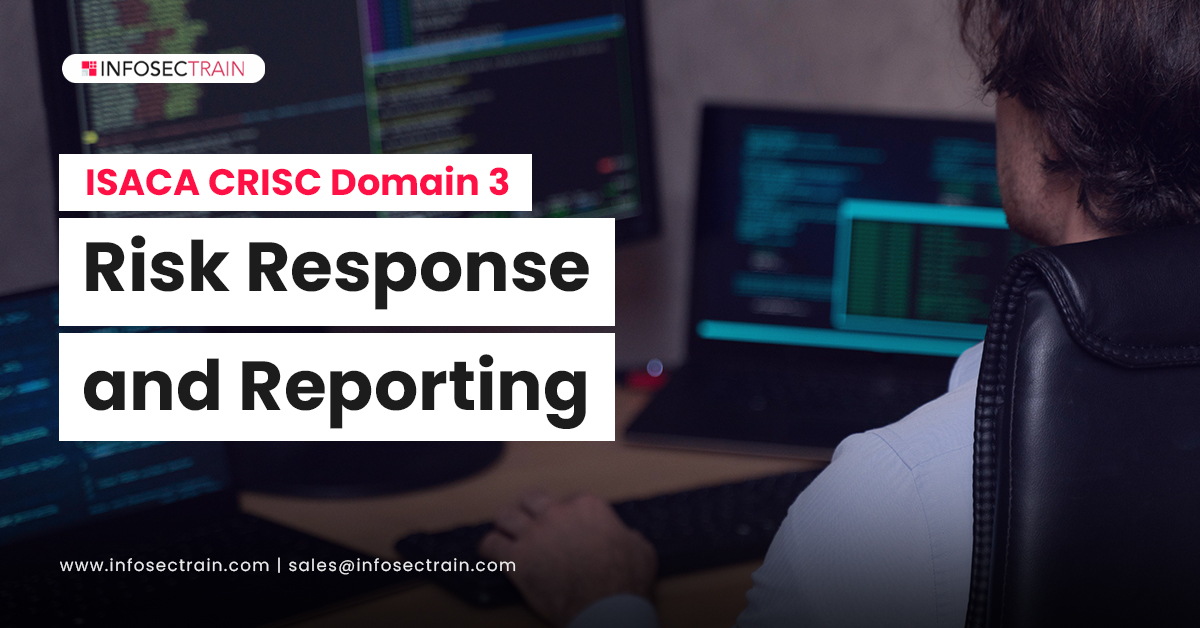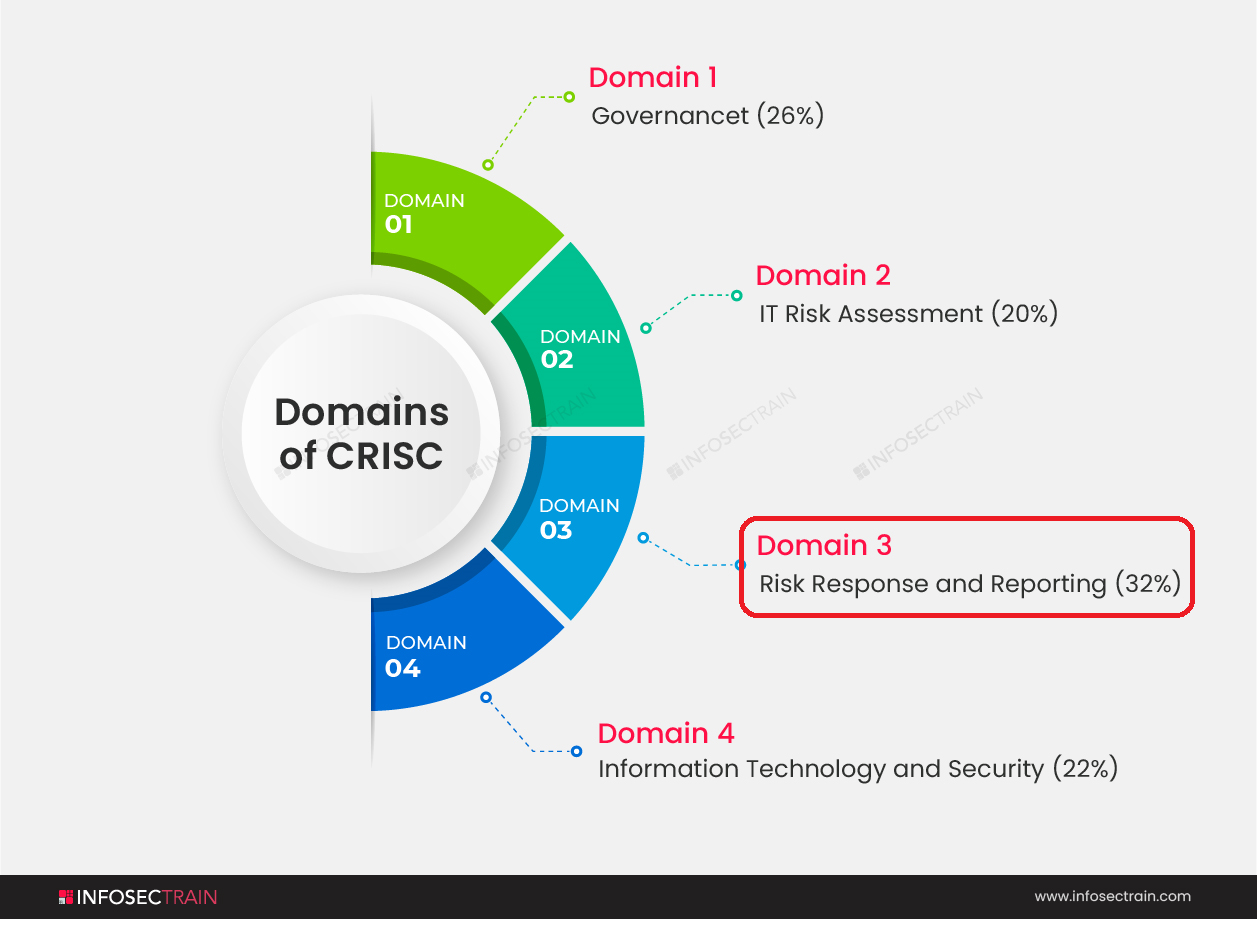ISACA CRISC Domain 3: Risk Response and Reporting

Domains of CRISC
CRISC comprises the following four domains, which basically explains the entire Risk Management Life Cycle:
- Domain 1: Governance (26%)
- Domain 2: IT Risk Assessment (20%)
- Domain 3: Risk Response and Reporting (32%)
- Domain 4: Information Technology and Security(22%)

We are going to explain the third domain that is ‘Risk Response and Reporting’.
Domain 3: Risk Response and Reporting
The third domain of CRISC that is Risk Response and Reporting comprises 32% weightage which is the highest weightage for this certification exam. This is not only the most important domain in the exam but also a crucial phase of the Risk Management Lifecycle.
The process of identifying strategic choices and deciding on measures to improve opportunities and decrease risks to the project’s objectives is known as risk response. Management must make judgments on how to respond to and handle risk as part of the risk response. The risk response choice is based on the information gathered throughout the IT risk assessment phase, but it is balanced against the restrictions imposed on the organization by budget, time, resources, strategic goals, regulations, and customer expectations. Management must be prepared to justify its risk response choice and offer a road map for making the adjustments decided on within an acceptable time frame. The risk response must ensure that corporate activity is protected while risk management methods are not too damaged or impacted.
The mechanism for articulating the value that the risk department delivers to an organization is risk reporting. It is the process of informing various stakeholders with real-time risk and performance data. It enables proactive risk management by allowing organizations to detect and escalate concerns as they occur or before they become apparent, allowing them to take a proactive approach to risk management.
This domain is further split into:
Risk Response
- Risk Treatment / Risk Response Options
- Risk and Control Ownership
- Third-Party Risk Management
- Issue, Finding, and Exception Management
- Management of Emerging Risk
Control Design and Implementation
- Control Types, Standards, and Frameworks
- Control Design, Selection, and Analysis
- Control Implementation
- Control Testing and Effectiveness Evaluation
Risk Monitoring and Reporting
- Risk Treatment Plans
- Data Collection, Aggregation, Analysis, and Validation
- Risk and Control Monitoring Techniques
- Risk and Control Reporting Techniques (heatmap, scorecards, dashboards)
- Key Performance Indicators
- Key Risk Indicators (KRIs)
- Key Control Indicators (KCIs)
This domain gives you the information you need to list the various risk response choices and specify various risk response characteristics. It also discusses the relationship between residual risk, inherent risk, risk appetite, and risk tolerance. When deciding on a risk response, it highlights the need of doing a cost-benefit analysis. It gives you a thorough understanding of how to create a risk action plan and discusses the ideas of risk ownership.
This domain also guarantees that you are familiar with KRIs, KCIs, and KPIs (Key Risk Indicators, Key Control Indicators, and Key Performance Indicators). Data collection, aggregation, analysis, and validation, as well as control types, standards, and frameworks, are all covered in this domain. It teaches you how to use various monitoring tools and approaches.
Task Statement of Domain 3
A CRISC applicant must be able to do the following tasks within this domain:
- Consult with risk owners to identify and connect suggested risk responses with company goals so that educated risk choices can be made.
- Consult with or help risk owners in developing risk action plans to ensure that important aspects are included (e.g. response, cost, target date).
- To ensure that the risk is managed to an appropriate level, consult on the design, installation, or adjustment of mitigating controls.
- To establish clear lines of responsibility, make sure control ownership is assigned precisely.
- Assist control owners in creating control procedures and documentation so that controls may be executed efficiently and effectively.
- To reflect changes in risk and management’s risk response, update the risk register.
- Verify that the risk response was carried out in accordance with the risk action plans.
- To allow monitoring of risk changes, define and develop Key Risk Indicators (KRIs) and thresholds based on available data.
- To identify changes or trends in the IT risk profile, monitor and evaluate Key Risk Indicators (KRIs).
- Report on any changes or trends in the IT risk profile to help management and other stakeholders make decisions.
- To allow the monitoring of control performance, make it easier to identify measurements and Key Performance Indicators (KPIs).
- Monitor and evaluate Key Performance Indicators (KPIs) to spot changes or trends in the control environment and assess control efficiency and effectiveness.
- Examine the outcomes of control evaluations to determine the control environment’s efficacy.
- Report on the entire risk profile and control environment’s performance, changes, and trends to key stakeholders to aid decision-making.
CRISC with InfosecTrain
CRISC Certification is a sign of risk assessment and information standard used for monitoring competence and skills. This certification equips the applicant with the necessary attitude to effectively advance up the professional ladder in today’s competitive environment. You must buckle down for the certification exam if you want to stand out from the crowd and expand your job possibilities.
InfosecTrain’s CRISC certification course will introduce you to the specific challenges of IT and business risk management. Because we are a significant training provider in the globe, we utilize highly qualified trainers who are experts in the field to create the entire action plan. Experienced professionals at InfoSecTrain will walk you through the process of building a solid CRISC foundation in order to upskill your risk management knowledge to a competent level. You can have a good chance of passing the exam on the first try if you have a solid approach, total devotion, and great resources. Join our training program and go on the fast track to success.




 1800-843-7890 (India)
1800-843-7890 (India) 
